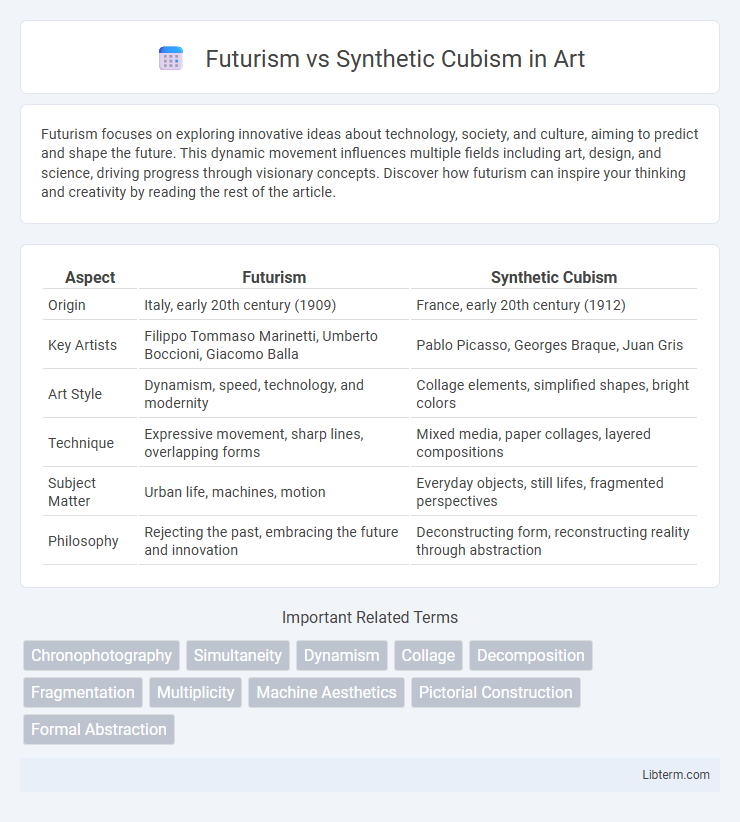Futurism focuses on exploring innovative ideas about technology, society, and culture, aiming to predict and shape the future. This dynamic movement influences multiple fields including art, design, and science, driving progress through visionary concepts. Discover how futurism can inspire your thinking and creativity by reading the rest of the article.
Table of Comparison
| Aspect | Futurism | Synthetic Cubism |
|---|---|---|
| Origin | Italy, early 20th century (1909) | France, early 20th century (1912) |
| Key Artists | Filippo Tommaso Marinetti, Umberto Boccioni, Giacomo Balla | Pablo Picasso, Georges Braque, Juan Gris |
| Art Style | Dynamism, speed, technology, and modernity | Collage elements, simplified shapes, bright colors |
| Technique | Expressive movement, sharp lines, overlapping forms | Mixed media, paper collages, layered compositions |
| Subject Matter | Urban life, machines, motion | Everyday objects, still lifes, fragmented perspectives |
| Philosophy | Rejecting the past, embracing the future and innovation | Deconstructing form, reconstructing reality through abstraction |
Introduction to Futurism and Synthetic Cubism
Futurism, originating in early 20th-century Italy, emphasized dynamic movement, technology, and the energy of modern life, breaking away from traditional art forms. Synthetic Cubism, developed by Pablo Picasso and Georges Braque around 1912, introduced collage elements and simplified shapes to reconstruct objects in abstract forms. Both movements challenged conventional representation but Futurism highlighted speed and industrial progress, while Synthetic Cubism focused on deconstructing and reassembling visual reality.
Defining the Core Principles
Futurism emphasizes dynamic movement, speed, and technology, capturing the energy of modern life through fragmented forms and vibrant colors. Synthetic Cubism, pioneered by Picasso and Braque, focuses on combining different textures, materials, and simplified shapes to create collage-like compositions that challenge traditional perspectives. Both movements deconstruct reality, but Futurism celebrates motion and progress, while Synthetic Cubism explores abstraction and the synthesis of multiple viewpoints.
Historical Context and Emergence
Futurism emerged in early 20th-century Italy, inspired by rapid industrialization, technology, and the dynamic energy of modern urban life, emphasizing movement and speed. Synthetic Cubism developed in France as a response to Analytical Cubism, incorporating collage and mixed media to reconstruct forms with simplified shapes and vibrant colors around 1912 to 1914. Both movements challenged traditional perspectives, reflecting the socio-political changes and artistic innovations preceding World War I.
Key Figures and Influencers
Futurism, spearheaded by Filippo Tommaso Marinetti and artists like Umberto Boccioni, emphasized dynamism, speed, and technology in early 20th-century Italian art, capturing the essence of modernity. Synthetic Cubism, pioneered by Pablo Picasso and Georges Braque, focused on assembling fragmented objects to create abstracted forms, marking a revolutionary shift in the perception of space and form. Both movements profoundly influenced avant-garde art, with Futurism advocating energetic movement and Synthetic Cubism exploring structural representation through collage and multiple perspectives.
Artistic Techniques and Visual Styles
Futurism emphasizes dynamic movement, speed, and the energy of modern technology, often using blurred lines, repeated forms, and vibrant color contrasts to convey motion and simultaneity. Synthetic Cubism, pioneered by Picasso and Braque, constructs images through the assembly of simplified shapes, collage elements, and flat planes, creating a fragmented yet harmonious composition that challenges traditional perspective. While Futurism captures the essence of mechanization and urban life with aggressive brushstrokes and rhythmic patterns, Synthetic Cubism focuses on deconstructing objects into geometric forms and reassembling them with textures and overlapping layers for a more abstract representation.
Representation of Movement and Form
Futurism and Synthetic Cubism both revolutionized the representation of movement and form, but with distinct approaches. Futurism emphasized dynamic motion and energy by depicting fragmented, overlapping figures to convey speed and technological progress. Synthetic Cubism, on the other hand, focused on reconstructing objects using simplified geometric shapes and collage elements, creating a flattened, abstracted form that challenges traditional perspective.
Use of Color and Composition
Futurism employs vibrant, dynamic colors and overlapping forms to convey movement and speed, emphasizing diagonal lines and fragmented shapes that create a sense of energy and motion. Synthetic Cubism, by contrast, favors a more restrained, muted palette with flat, simplified shapes and collage-like compositions, focusing on the assembly of diverse materials and textures to depict objects from multiple perspectives simultaneously. While Futurism prioritizes fluidity and the illusion of time passing, Synthetic Cubism emphasizes structural composition and spatial ambiguity through static, layered elements.
Impact on Modern Art Movements
Futurism accelerated the use of dynamic motion and technology in art, influencing later movements like Abstract Expressionism and Kinetic Art by emphasizing speed and innovation. Synthetic Cubism introduced collage and mixed media techniques, revolutionizing visual representation and shaping the development of Dadaism and Surrealism through fragmented perspectives. Both movements fundamentally challenged traditional aesthetics, paving the way for experimental approaches that defined 20th-century modern art.
Lasting Legacy and Contemporary Influence
Futurism revolutionized the portrayal of dynamism and technology, significantly influencing modern design, digital art, and performance aesthetics with its emphasis on movement and speed. Synthetic Cubism introduced innovative techniques of collage and abstraction, shaping contemporary visual languages in multimedia, graphic design, and conceptual art. Both movements continue to inspire contemporary artists by challenging traditional perspectives and encouraging experimental approaches to form and narrative.
Comparative Analysis: Futurism vs Synthetic Cubism
Futurism emphasizes dynamic movement, speed, and the energy of modern technology through fragmented forms and vibrant color palettes, capturing the essence of industrial progress and motion. Synthetic Cubism, pioneered by Picasso and Braque, focuses on the assembly of simplified shapes, collage elements, and muted colors to reconstruct objects from multiple viewpoints, highlighting abstraction and conceptual depth. While Futurism celebrates technological advancement and kinetic energy, Synthetic Cubism deconstructs reality into geometric forms, emphasizing compositional structure and symbolic representation.
Futurism Infographic

 libterm.com
libterm.com